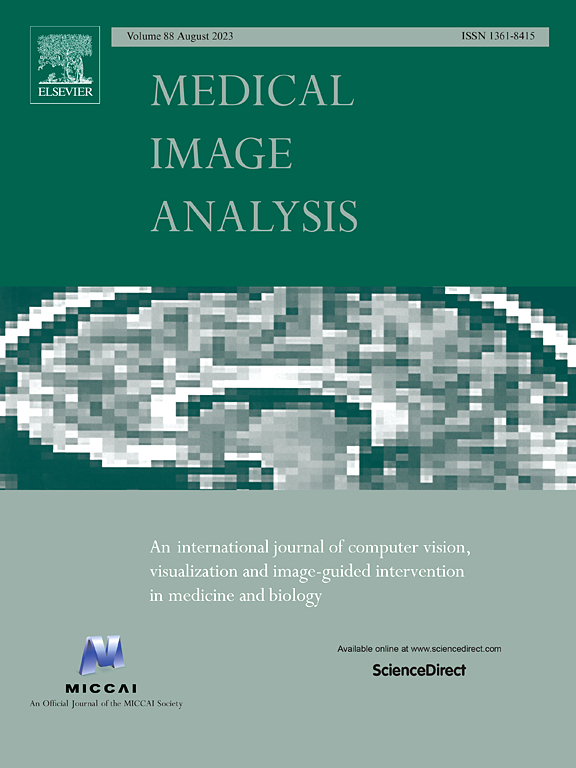用于解剖学引导的头颈部 CT 可变形配准的 MUsculo-Skeleton-Aware (MUSA) 深度学习。
IF 10.7
1区 医学
Q1 COMPUTER SCIENCE, ARTIFICIAL INTELLIGENCE
引用次数: 0
摘要
与耗时的非深度学习方法相比,基于深度学习的可变形图像配准(DL-DIR)在各种解剖部位的精确度都有所提高。然而,在具有较大变形的异质组织区域,DL-DIR 仍然具有挑战性。事实上,在头颈部计算机断层扫描(CT)图像上进行测试时,几种最先进的 DL-DIR 方法都无法捕捉到解剖学上合理的大变形。这些结果表明,这种复杂的头颈部变形可能超出了单一网络结构或均匀平滑正则化的能力范围。为了应对头颈部多尺度肌肉骨骼运动和软组织综合变形的挑战,我们提出了一种多尺度骨骼感知(MUSA)框架,利用显式多分辨率策略以及骨性结构和软组织之间的非均质变形约束,从解剖学角度指导 DL-DIR。所提出的方法将复杂变形分解为整体姿势变化和残余精细变形。该方法可用于主体间和主体内的配准。我们的研究结果表明,MUSA 框架可以持续提高配准精度,更重要的是,可以提高各种网络结构的变形可信度。代码将在 https://github.com/HengjieLiu/DIR-MUSA 上公开发布。本文章由计算机程序翻译,如有差异,请以英文原文为准。
MUsculo-Skeleton-Aware (MUSA) deep learning for anatomically guided head-and-neck CT deformable registration
Deep-learning-based deformable image registration (DL-DIR) has demonstrated improved accuracy compared to time-consuming non-DL methods across various anatomical sites. However, DL-DIR is still challenging in heterogeneous tissue regions with large deformation. In fact, several state-of-the-art DL-DIR methods fail to capture the large, anatomically plausible deformation when tested on head-and-neck computed tomography (CT) images. These results allude to the possibility that such complex head-and-neck deformation may be beyond the capacity of a single network structure or a homogeneous smoothness regularization. To address the challenge of combined multi-scale musculoskeletal motion and soft tissue deformation in the head-and-neck region, we propose a MUsculo-Skeleton-Aware (MUSA) framework to anatomically guide DL-DIR by leveraging the explicit multiresolution strategy and the inhomogeneous deformation constraints between the bony structures and soft tissue. The proposed method decomposes the complex deformation into a bulk posture change and residual fine deformation. It can accommodate both inter- and intra- subject registration. Our results show that the MUSA framework can consistently improve registration accuracy and, more importantly, the plausibility of deformation for various network architectures. The code will be publicly available at https://github.com/HengjieLiu/DIR-MUSA.
求助全文
通过发布文献求助,成功后即可免费获取论文全文。
去求助
来源期刊

Medical image analysis
工程技术-工程:生物医学
CiteScore
22.10
自引率
6.40%
发文量
309
审稿时长
6.6 months
期刊介绍:
Medical Image Analysis serves as a platform for sharing new research findings in the realm of medical and biological image analysis, with a focus on applications of computer vision, virtual reality, and robotics to biomedical imaging challenges. The journal prioritizes the publication of high-quality, original papers contributing to the fundamental science of processing, analyzing, and utilizing medical and biological images. It welcomes approaches utilizing biomedical image datasets across all spatial scales, from molecular/cellular imaging to tissue/organ imaging.
 求助内容:
求助内容: 应助结果提醒方式:
应助结果提醒方式:


